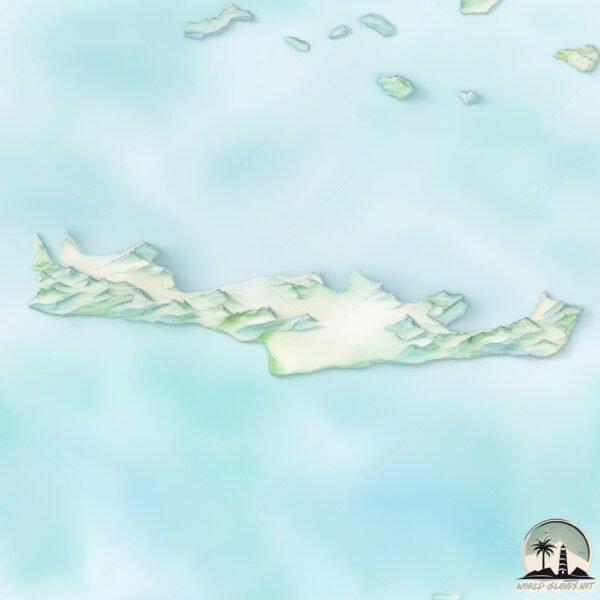Welcome to Crete , a Temperate island in the Aegean Sea, part of the majestic Atlantic Ocean. This guide offers a comprehensive overview of what makes Crete unique – from its geography and climate to its population, infrastructure, and beyond. Dive into the details:
Geography and size of Crete
Size: 8296 km²Coastline: 1033 kmOcean: Atlantic OceanSea: Aegean SeaContinent: Europe
Crete is a Very Large Island spanning 8296 km² with a coastline of 1033 km.
Archipel: Mediterranean islands – Encompassing numerous islands in the Mediterranean Sea, each with its own unique culture, history, and natural beauty, from the Balearics to the Greek islands.
Tectonic Plate: Aegean Sea – Located in the eastern Mediterranean, this microplate is characterized by seismic and volcanic activity due to its interaction with the Eurasian and African Plates.
The geographic heart of the island is pinpointed at these coordinates:
Climate and weather of Crete
Climate Zone: TemperateClimate Details: Hot-Summer Mediterranean ClimateTemperature: Hot Summer
Climate Characteristics: Characterized by hot, dry summers and mild, wet winters, typical of coastal areas with abundant sunshine.
Topography and nature of Crete
Timezone: UTC+02:00Timezone places: Europe/MariehamnMax. Elevation: 2456 m PsiloritisMean Elevation: 486 mVegetation: Agricultural MosaicTree Coverage: 19%
The mean elevation is 486 m. Dominating the island’s landscape, the majestic “Psiloritis” rises as the highest peak, soaring to impressive heights. The island is characterized by Mountains: High, steeply elevated landforms. Characterized by both a high maximum elevation (over 500 meters) and a high mean elevation, creating rugged, mountainous terrains on islands.
Dominating Vegetation: Agricultural Mosaic
Vegetation: 15 vegetation zones – Exceptionally Diverse Island
Infrastructure and Travelling to Crete
Does the island have a public airport? yes .
Does the island have a major port? yes .
The mean population of Crete is 77 per km². Crete is Gently Populated. The island belongs to Greece .
The name of the island resonates across different cultures and languages. Here is how it is known around the world: Arabic: كريت; German: Kreta; Spanish: Creta; French: Crète; Portuguese: Creta; Russian: Крит; Chinese: 克里特
Continuing your journey, Nisí Día is the next notable island, situated merely km away.
Top 10 Places To Visit in Crete - Greece Travel Guide
Crete is one of Greece's most stunning islands. Enjoy this travel guide featuring the beaches and wonders of Crete. From the ...
Top 10 Places To Visit in Crete - Greece Travel Guide
Crete is one of Greece's most stunning islands. Enjoy this travel ...
Crete is one of Greece's most stunning islands. Enjoy this travel guide featuring the beaches and wonders of Crete. From the ...
Why CRETE is the BEST GREEK ISLAND
What is the best Greek island ? Spoiler : it's Crete. But what is ...
What is the best Greek island ? Spoiler : it's Crete. But what is Crete famous for ? And how do you get from Athens to Crete ?
CRETE TRAVEL GUIDE & COST 2025
GREECE'S ULTIMATE ISLAND!
Ad Check out Discover Cars for great budget car rental deals in Crete ...
Ad Check out Discover Cars for great budget car rental deals in Crete and around the world here: ...
Greece is classified as Developed region: nonG7: Developed economies outside of the Group of Seven, characterized by high income and advanced economic structures. The level of income is High income: OECD.
News – Latest Updates and Headlines from Crete
Stay informed with the most recent news and important headlines from Crete. Here’s a roundup of the latest developments.
Loading...
Social Media Posts about Crete
Loading...
Please note: The data used here has been primarily extracted from satellite readings. Deviations from exact values may occur, particularly regarding the height of elevations and population density. Land area and coastline measurements refer to average values at mean high tide.

